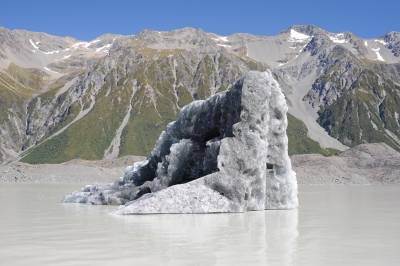
By Jeremy Hsu
"Iceberg, dead ahead!"
The cry that heralded the Titanic's doom may now signal hope for thirsty people around the world, if glaciologists and engineers can somehow harness flotillas of icebergs at the frozen corners of the Earth. Such a dre am took a step forward recently when a French team simulated how to tow an iceberg from the Arctic to countries that need fresh drinking water.
Ambitions for making icebergs into the world's drinking fountains began with Saudi Prince Mohammed al Faisal in the 1970s. Al Faisal, nephew of Saudi Arabia's King Khalid, teamed up with French engineer Georges Mougin to create an ill-fated company based on tapping iceberg water. Since 2003, Mougin has resurrected the idea with the help of computer modeling from the French company Dassault Systemes.
The recent simulations stood as virtual trial runs for Mougin's $11.5 million (€ 8 million) plan to drag an iceberg from Greenland to the Canary Islands off the northwest coast of Africa. They showed that just one heavy-duty tugboat can make the trip in about 140 days while dragging an iceberg weighing 7 million tons — enough to meet the annual water consumption of 35,000 people.
"We created an overall virtual world, which could provide Mougin a way to simulate the iceberg transportation operation as it would happen in reality, while monitoring the fuel consumption of the tug-boat and the iceberg melt along the route of the convoy," said Cedric Simard, project director at Dassault Systemes.
Still, towing the iceberg all that way won't do any good if the ocean's ravages speed up melting at the waterline. Fortunately, the simulations also suggested that a floating textile skirt almost 40 feet (12 meters) high — designed by Mougin — could protect the iceberg from such seawater erosion.
A real-world trial could take place by 2012 or 2013, Mougin said. Some tabular icebergs seen as ideal for such operations exist in Greenland, and a huge number come from Antarctica.
But first, the textile belt must be built and tested.
"Mougin is currently working on refining the design of the geotextile skirt: it all depends on the materials he will decide to use in the end," Simard told InnovationNewsDaily.
Any venture would also have to be prepared to deal with unpredictable weather and rough seas. There is also the rare but dangerous possibility of an iceberg fracture — simulations of such a breakup suggest "total chaos" that includes waves almost 200 feet (60 meters) high.
Mougin and his team must also prove that such operations could become cost-effective ways for getting water. The $11.5 million price tag for the one-shot operation is far from that, Simard said. But he added that they could round up even bigger icebergs that could lead to a greater harvest and bring the price down.
If the simulation can plug directly into a satellite database for real-time ocean weather tracking, it might even help future tugboat pilots safely steer with an iceberg in tow. Otherwise, Simard hopes to improve on how the simulation models the behavior of human tugboat pilots in the virtual world.
Article courtesy of yahoo.com
Image courtesy of Federico Stevanin

